How to Store Wine After Opening [7 Essential Rules]
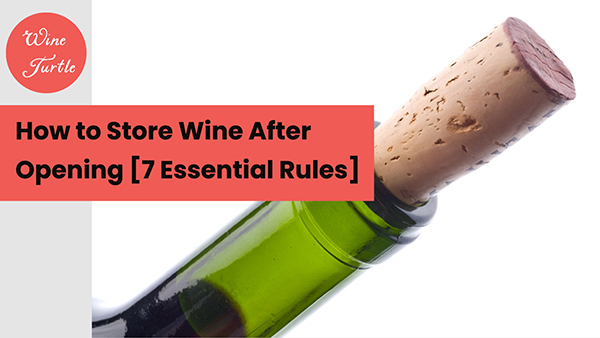
We've all been there. You really want a glass of that bottle of wine you bought earlier but you can't finish the bottle tonight and you won't be in tomorrow.
It's just not worth opening right?
Fear not! There's no need to despair if you know how to store an opened bottle of wine properly!
Follow these wine preservation rules to keep your opened wine tasting fresh for as long as possible.
How to Keep Wine Fresh After Opening
Essentially, the less oxygen that comes into contact with wine, the longer it will last after opening.
Oxygen is usually beneficial to wine that we will imminently drink and that's why we aerate and decant bold wines. But, we're talking an hour or two at the very most here.
If you plan on keeping wine fresh for the coming days once it has been opened then you need to seriously restrict the amount of oxygen that reaches the leftover wine.
Oxidation is the reaction that occurs in wine when oxygen is present and it causes the flavors and aromas to become dull.
Oxygen also enables another reaction to take place where ethanol (alcohol) converts into acetic acid. Besides water, acetic acid is the main component of vinegar. I like my wine vinegar free, thank you!
There are many ways we can restrict the influence of oxygen on our wine and by implementing most of them you can keep wine fresh for longer.
Here's how!
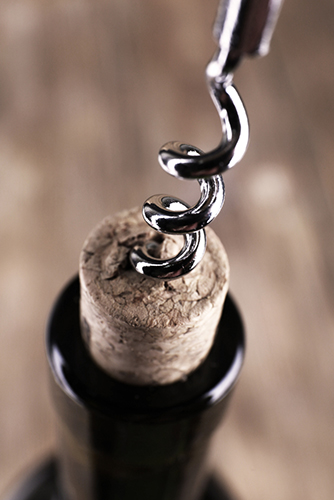
7. Keep Bottles Upright After Opening
When a bottle of wine is opened, it immediately gets exposed to oxygen.
By storing the bottle upright, the surface area of the wine that is exposed to air is minimized, slowing down the oxidation process.
This is in stark contrast with how a wine bottle should be stored before it has been opened (on its side!).
6. Recork Immediately After Pouring
Excessive exposure to oxygen is what makes a wine spoil after opening. It's really important that we limit the interaction of wine with oxygen in the air as much as possible.
That means putting the cork (or a stopper) back on as soon as possible after each pour.
If you are reusing the cork then always try and put the same end back in the bottle. Otherwise, you risk contaminating the wine. I always use reusable stoppers as it's not always easy to get a cork back in.
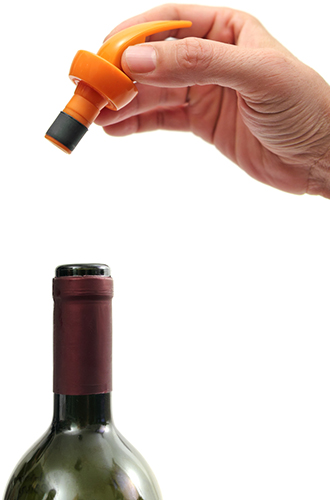
5. Keep Your Wine Cold
So, you put the cork back on the bottle quickly after pouring and you've got your bottle in the upright position, what next?
The next step is to keep your wine cold. Earlier, we learned that the interaction of oxygen with wine causes damaging oxidation. The truth is, we can't actually stop this from happening. However, we can slow oxidation down considerably by keeping the wine cold (and following the other best practices).
So, if you want to preserve your wine for as long as possible after opening then store it in the fridge. With all other things equal, wine stored in the fridge will last for longer than wine at room temperature. Another benefit of the fridge is that it's dark, and we'll discuss that in more detail now.
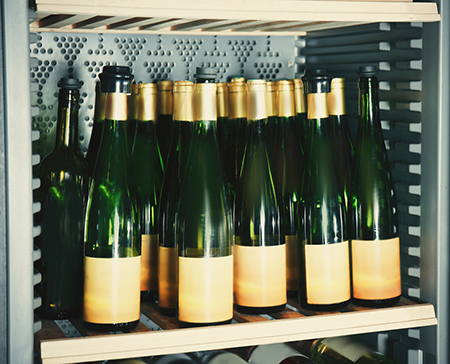
4. Keep it Away From Sunlight
Sunlight is really bad news for both opened and unopened wine. Ultraviolet light causes chemical reactions in wine that are really bad news for our tastebuds!
The effect is summed up well in a 2008 study by Andy Hartley (The Effect of Ultraviolet Light on Wine Quality, ISBN: 1-84405-386-5 WRAP.org.uk ):
"Sulphurous compounds are an integral constituent of wine which under certain circumstances will breakdown into smaller constituents, some of which have an extremely unpleasant smell and taste;"
"UV radiation in particular and, to a lesser extent, visible light promotes (catalyses) these unwanted reactions;"
He concludes by stating:
"The damaging reactions occur rapidly; a detectable loss in quality can occur in a matter of hours."
The original report seems to have moved but you can read it here.
It's pretty scary stuff but he does mention that colored bottles can help to protect the wine to some degree. Also, that tannins can help to protect wine too.
3. Use a Wine Preservation Device
To keep your wine fresher for longer then a wine preserver is the way to go. There are various devices on the market that work in different ways to slow the process of oxidation that will eventually ruin your wine.
You can get a few extra days of life out of your wine and even a few extra months with the most recent wine preservers from Coravin.
Just be warned, these devices range from quite expensive to very expensive. Here's a brief run-through on what's available:
Vacuum Pumps
These wine preservers are on the cheaper end of the scale and to be honest they can be pretty good.
The Vacu Vin Wine Saver was the original and it's probably still the best. You can get an extra few days of life out of an opened bottle of wine compared to simply recorking and putting it in the fridge.
It works by removing the air from inside the bottle. You insert the special stopper and then use the pump until you hear a click. This means the air has been removed and there's an air-tight seal.
As it gets rid of the pesky oxygen it also allows you to store wine bottles on their side if you should need to.
Another big plus here is that it's reusable, unlike some of the others that we'll see.
Inert Gas Spray
These are cans of dense, unreactive gas like argon that work by forming a protective layer on the surface of the wine.
You spray the gas inside the bottle and recork it immediately. The gas sinks down and applies a preservative layer on top of the wine. This means no more oxygen should reach it.
These tend to cost $10-$15 and should help to preserve 50-100 bottles of wine. In my experience, they'll give you an extra few days at most.
Private Preserve is one of the better options available.
Coravin
If you want your opened wine bottle to last as long as possible and you've got money to spare then the Coravin System is the solution for you.
It utilizes inert gas but deploys it in such a unique way that it means you don't actually need to uncork the wine bottle.
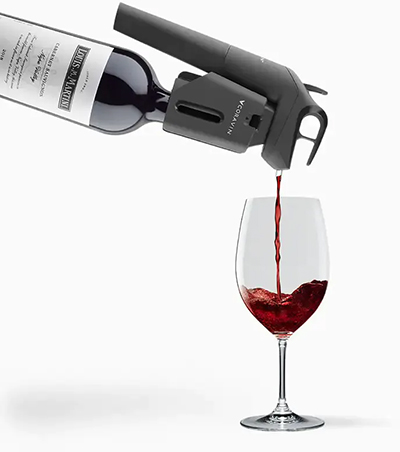
The newest Coravin Timeless Systems use a hollow needle that pierces through the cork. You can then pour the bottle through the Coravin device by holding a trigger. As you pour, argon gas replaces the wine in the bottle, preventing oxygen from damaging the wine.
When you remove the Coravin device from the bottle, the cork is sealed and you can put the bottle away again like it was never opened. Pretty cool huh?
These things are great and they can keep opened wine bottles tasting great for weeks and sometimes even months. However, they are expensive and range in price from around $100 to over $500.
The Coravin Timeless is the latest iteration and preserves an opened bottle of wine for the longest. I've seen it available from directly from Coravin and also on Amazon (affiliate link).
The Coravin Pivot is the cheapest version available.
Sparkling Wine Stopper
Sparkling wines require a slightly different solution in order to preserve those delicate little bubbles. To be honest, I wouldn't dream of leaving a bottle of bubbly unfinished but you never know what lies in store!
Just don't believe all the sales hype you'll read with these. It's not uncommon to see claims of opened bottles of bubbly lasting for weeks, which just isn't true.
In my experience, you can save the bubbles for two days or maybe three days at a push. That's still very impressive and beats pouring flat Champagne down the sink!
I like the Champagne Crown Sealer from Le Creuset the best as it has a significantly better build quality than most other options. It's durable, easy to clean, and backed by a really solid warranty.
But, it's pretty expensive.
A great alternative is the Champagne stopper from Cuisinart, which works just as well.
2. Decant into a Smaller Bottle
If you have half a bottle of wine left then half of the bottle is now filled with air. What's more, now the wine is past the neck of the bottle, the surface area of the wine that is in contact with the air is at its largest.
You can improve this situation by decanting the wine into a smaller bottle. A 375 ml bottle or even 150 ml bottles are available from stores specializing in winemaking or brewing.
By filling the bottles up to the neck and sealing them you are limiting the amount of oxygen that can degrade your wine over the coming days.
1. Know Your Wine: How Long Should It Keep?
When it comes to the shelf life of wine after opening there's a huge amount of variance across the different wine varieties.
By understanding the expectations of each wine you open you can ensure that you always drink it at its best.
For instance, bold, tannic red wines tend to last the longest but organic versions will spoil more quickly due to the lack of preservative sulfites.
Similarly, mature wines will require decanting to aerate them but you probably want to drink them there and then as they will start to degrade quickly.
Sparkling wine and light-bodied wines will keep the shortest amount of time.
Don't miss our guide if you want to find out how long various types of wine last after opening!
Conclusion
There are basically two simple rules for storing wine after opening that condense a lot of what I covered above.
They won't cost you any money and will slow down the rate at which your wine spoils.
- 1Keep your wine corked.
- 2Keep your wine bottle upright in the refrigerator.
Stick to them and you'll preserve your wine for a few days (depending on the varietal).
But, if you want your wine to stay fresh for longer then you'll need to invest in a specialist wine preservation system. These can extend the lifespan of an opened bottle of wine to as much as a few weeks or even months.
Make sure you store your wine properly in the first place, preferably in a wine fridge or wine cellar (or equivalent). Otherwise, if it has already been exposed to heat, light, or vibrations then you may find your wine spoiling quicker than it should.
Do you have any quirky tricks for keeping wine tasting fresh for longer? I'd love to hear about them in the comments section!
